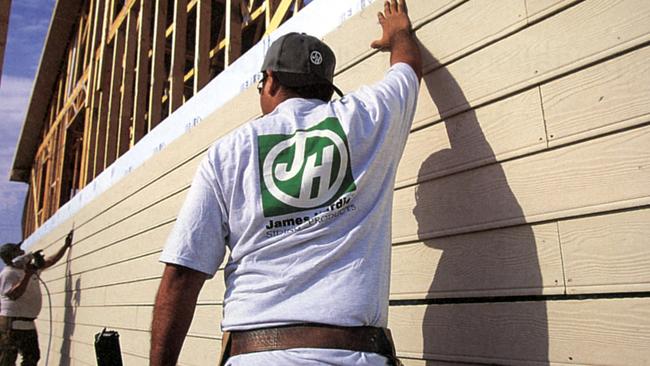Why James Hardie directors may be showing early signs of retreat on unpopular takeover


James Hardie’s backflip on allowing shareholders to vote on a shift to having a main stock exchange listing in the US has provided some investors with hope that directors may back away from its $14bn buyout deal with Azek.
Major Australian investors in James Hardie remain in talks with their lawyers about their options with respect to calling an extraordinary general meeting to sack the board before the annual general meeting or taking direct legal action against directors.
This is over the highly unpopular deal, which some were concerned was an excuse to discreetly move its main stock exchange listing to the US irrespective of whether the transaction presented good value to shareholders.
Such avenues to sack the board remain challenging before the company is combined with Azek, which would happen by the time of the AGM, with Azek shareholders then owning about 25 per cent of the stock.
But, the understanding is many are hoping they can reach a resolution with directors where they agree to walk away from buying the target which would see James Hardie enter into selling building materials like decking, a shift from its highly lucrative fibre cement product.
The drawcard is that directors preserve their jobs and would not be voted off the board.
If the deal was in fact part of a move to justify a shift of its main listing to the US, where James Hardie does most of its business, it could be argued the Azek deal lacks the same appeal without the ability to have the listing there.
A $US273m break fee is payable for extracting itself from the transaction, but some shareholders see no positive outcome following the buyout plans.
More shareholder value would be eroded through owning Azek - the stock has lost at least $3bn already of value in just weeks, as investors sold on the back of the buyout deal.
James Hardie paid a 37.4 per cent premium for Azek, equating to 20 times its net profit, and the stock fell 15 per cent on the day of the announcement, with shareholders dubious about the announced synergy benefits.
Meanwhile, although Australian shareholders may be angry about the deal, some believe directing their anger towards the ASX — for allowing a waiver which would normally require a vote to allow a placement and stock exchange shift — was misdirected.
It has prompted debate about whether a review by the exchange into waiver rules do much in holding directors accountable in the future.
Removing waivers would take away flexibility of application, but the bigger issue is the application of the rules, where the ASX looked at the overall context of what the company was trying to achieve when determining whether they would be granted.
In the case of James Hardie, it sought to be excused from listing rules that say a company cannot conduct a placement of over 15 per cent of the stock with either cash or shares.
Waivers are allowed when the deal involves an entity from a foreign jurisdiction.
Market and legal experts say the real problem with the deal was shareholders considered James Hardie was overpaying in a takeover.
The company was not transparent, in that it did not spell out reasons why it wanted an exemption from rules granted, and effectively has moved to force through a major transaction that was highly unpopular.
But, the ASX’s responsibilities do not extend to determining whether a company’s transaction is commercially sound.
This was something shareholders needed to address directly by either calling an EGM to roll the board or by taking legal action against directors personally if they had not acted in their best interests.
One positive outcome could be a review that may see rules tweaked, where groups need to provide better disclosure on why they are seeking a waiver for a placement, or else a change to waivers required when issuing more than 100 per cent of stock, making it a lower amount.
As it stands, the current ASX listing rules are very similar to other western jurisdictions, including the NYSE, where James Hardie is also listed.
In the US, companies need a waiver for placements over 20 per cent, while the stock exchange in London has recently relaxed similar rules to make them more flexible.
The ASX granted large placement exemptions last year to Westgold for its acquisition of the $2.2bn Canada-based Karora Resources and Paladin Energy for its $1.3bn Canada-based Fission purchase
Another area the ASX could focus on is making rules when shareholders are trying to roll a board to hold an EGM within a specific time frame - currently two months after calling a meeting within 21 days of the request.
But, in a similar instance involving NZME where activist shareholders are have been trying to sack the board and replace directors at its annual general meeting, the company pushed back the AGM date by about three months, and the argument for doing so was shareholders needed more time to consider implications.
In the case of James Hardie, one argument is, should its directors delay an EGM, shareholders should take legal action against board members personally for failing in their duties.
One of the challenges for James Hardie has been it has not had activist investors on the register agitating for change.
And because it is headquartered in Ireland, the ASX would not have any say anyway over when and how it held an EGM because it would fall under the Irish listing rules.
Lobbying for change to ASX rules following the James Hardie transaction had been some of the biggest ASX-listed company investors, including Mark Delaney from AustralianSuper, Fidelity’s Paul Taylor, UniSuper’s John Pearce, Allan Gray’s Simon Mawhinney, Airlie’s Matt Williams, Troy Angus from Paradice, Andrew Fleming from Schroder and Ausbil’s Paul Xiradis.





To join the conversation, please log in. Don't have an account? Register
Join the conversation, you are commenting as Logout